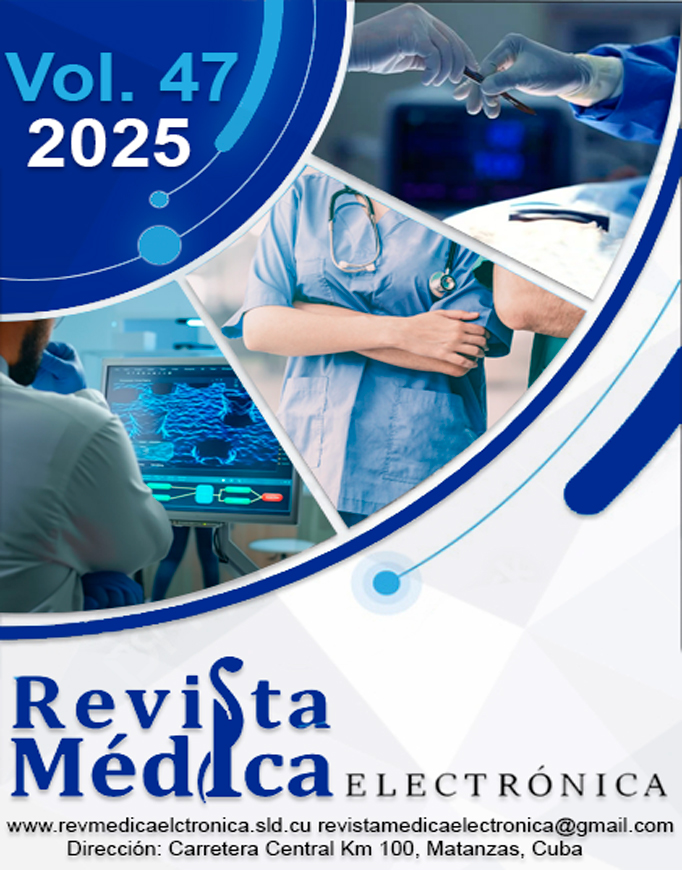Cutaneous reactogenicity to Cladosporium associated with allergic hypersensitivity in symptomatic patients. 2019-2020
Keywords:
Prick test, cutaneous reactogenicity to airborne allergens, allergy to anemophilous fungiAbstract
Introduction: Anemophilous fungi are one of the causes of hypersensitivity by inhalable allergens. Specimens of the genus Cladosporium stand out for their high frequency.
Objective: To describe the cutaneous reactogenicity of crude extracts of fungi of the genus Cladosporium spp. in Cuban patients with type I hypersensitivity.
Method: Analytical observational study in a representative sample (m=170) of patients with recurrent symptoms associated with type I hypersensitivity, treated between January 2019 and December 2020 at the University Hospital General Calixto García. Cutaneous reactogenicity was evaluated using the Prick test.
Results: With an m=170 and age range of 18;83 years, with an ẋe=41.83±2.56 years, 77.05% of the tested subjects showed sensitivity to at least one genus of fungus, with 38.82 % of subjects sensitized to Cladosporium spp. 53.03 % of the female sex vs. 48.48% of the male sex. In general, there were no differences between sexes (X2=0.2075; p=0.6487) or age (X2=0.0237; p=0.8775) regarding positivity to Cladosporium. The cross-reactivity of Cladosporium with other anemophilous fungi was striking, with a higher proportion of Fusarium and Chrysonilia in women vs. men. In the analysis of the absolute proportions of stationary reactivity, the lower incidence of new cases in the months of February and August was statistically significant (p=0.000*).
Conclusions: The proportion of patients with recurrent symptoms associated with type I hypersensitivity sensitized to specimens of the genus Cladosporium is high, without distinction according to sex, with an apparent tendency to a pluri-sensitivity in women vs. major cutaneous reaction for men.
Downloads
References
1. Kurup VP, Shen HD, Banerjee B. Respiratory fungal allergy. Microbes Infect. 2000;2(9):1101-10. DOI: 10.1016/s1286-4579(00)01264-8.
2. Instituto Nacional de Seguridad y Salud en el Trabajo. Cladosporium spp [Internet]. Madrid: Ministerio del Trabajo y Economía Social; 2022 [citado 21/02/2023]. Disponible en: https://www.insst.es/agentes-biologicos-basebio/hongos/cladosporium-spp
3. Sharpe RA, Bearman N, Thornton CR, et al. Indoor fungal diversity and asthma: a meta-analysis and systematic review of risk factors. J Allergy Clin Immunol. 2015;135(1):110-22. DOI: 10.1016/j.jaci.2014.07.002.
4. Bensch K, Groenewald JZ, Braun U, et al. Common but different: The expanding realm of Cladosporium. Stud Mycol. 2015;82:23-74. DOI: 10.1016/j.simyco.2015.10.001.
5. Bensch K, Groenewald JZ, Meijer M, et al. Cladosporium species in indoor environments. Stud Mycol. 2018;89:177-301. DOI: 10.1016/j.simyco.2018.03.002.
6. Salvatore MM, Andolfi A, Nicoletti R. The Genus Cladosporium: A Rich Source of Diverse and Bioactive Natural Compounds. Molecules. 2021;26(13):3959. DOI: 10.3390/molecules26133959.
7. Lu Y, Wang X, Almeida LCSS. Environmental Factors Affecting Diversity, Structure, and Temporal Variation of Airborne Fungal Communities in a Research and Teaching Building of Tianjin University, China. J Fungi. 2022;8(5):431. DOI: 10.3390/jof8050431.
8. Ma X, Hu J, Yu Y, et al. Assessment of the pulmonary adaptive immune response to Cladosporium cladosporioides infection using an experimental mouse model. Sci Rep. 2021;11(1):909. DOI: 10.1038/s41598-020-79642-y.
9. Dreborg S. Standardization of allergenic preparations by in vitro and in vivo methods. Allergy. 1993;48(s14):63-70. DOI: 10.1111/j.1398-9995.1993.tb04759.x.
10. Kespohl S, Liebers V, Maryska S, et al. What should be tested in patients with suspected mold exposure? Usefulness of serological markers for the diagnosis. Allergol Select. 2022;6(1):118-32. DOI: 10.5414/ALX02298E.
11. Pfeiffer S, Swoboda I. Problems Encountered Using Fungal Extracts as Test Solutions for Fungal Allergy Diagnosis. J Fungi. 2023;9(10):957. DOI: 10.3390/jof9100957.
12. Karadoğan D, Telatar TG, Dönmez H, et al. Relationship between aeroallergen sensitization pattern and clinical features in adult asthmatics. Heliyon. 2023;9(5):e15708. DOI: 10.1016/j.heliyon.2023.e15708.
13. Eidstø E, Selinheimo S, Lampi J, et al. The Continuum of Severity of Functional Impairment Due to Indoor Air Symptoms: Prevalence and Determinants. J Occup Environ Med. 2023;65(9):717-24. DOI: 10.1097/JOM.0000000000002884.
14. Zheng Y, Dang EV. Novel mechanistic insights underlying fungal allergic inflammation. PLoS Pathog. 2023;19(9):e1011623. DOI: 10.1371/journal.ppat.1011623.
15. Pham DL, Le KM, Truong DDK, et al. Environmental allergen reduction in asthma management: an overview. Front allergy. 2023;4:1229238. DOI: 10.3389/falgy.2023.1229238.
16. Trinh TH, Nguyen PT, Tran TT, et al. Profile of aeroallergen sensitizations in allergic patients living in southern Vietnam. Front allergy. 2022;3:1058865. DOI: 10.3389/falgy.2022.1058865.
17. Dirección de Registros Médicos y Estadísticas de Salud. Anuario estadístico de salud 2021 [Internet]. La Habana: MINSAP; 2022 [citado 21/02/2023]. Disponible en: https://temas.sld.cu/estadisticassalud/2022/10/
18. Sánchez Espinosa KC, Almaguer Chávez M, Pérez Ramírez I, et al. Diversidad fúngica en la atmósfera de la habana (cuba) durante tres períodos poco lluviosos. Rev int contam ambie [Internet]. 2019 [citado 18/02/2023];35(1):137-50. Disponible en: https://www.revistascca.unam.mx/rica/index.php/rica/article/view/RICA.2019.35.01.10
19. Almaguer M, Aira MJ, Rodríguez-Rajo FJ, et al. Thirty-four identifiable airborne fungal spores in Havana, Cuba. Ann Agric Environ Med. 2015;22(2):215-20. DOI: 10.5604/12321966.1152068.
20. Forkel S, Beutner C, Schröder SS, et al. Sensitization against Fungi in Patients with Airway Allergies over 20 Years in Germany. Int Arch Allergy Immunol. 2021;182(6):515-23. DOI: 10.1159/000512230.
21. Nazari Z, Ghaffari J, Ghaffari N, et al. Una revisión sobre las reacciones de hipersensibilidad a los aeroalérgenos fúngicos en pacientes con trastornos alérgicos en Irán. Curr Med Mycol. 2019;5(1):42-7. DOI: 10.18502/cmm.5.1.537.
22. Tayeb MMS. The relationship between mold sensitization and allergic diseases: a retrospective study (Jeddah, Saudi). AIMS Allergy Immunol. 2020;4(1):14-9. DOI: 10.3934/Allergy.2020002.
23. Hasnain SM, Al-Frayh AS, Al-Suwaine A, et al. Cladosporium and respiratory allergy: Diagnostic implications in Saudi Arabia. Mycopathologia. 2004;157:171-9. DOI: 10.1023/B:MYCO.0000020592.72238.a6.
24. Li Y, Steenwyk JL, Chang Y, et al. A genome-scale phylogeny of the kingdom Fungi. Curr Biol. 2021;31(8):1653-65.e5. DOI: 10.1016/j.cub.2021.01.074.
25. van der Valk JPM, Gerth van Wijk R, Hoorn E, et al. Measurement and interpretation of skin prick test results. Clin Transl Allergy. 2015;6:8. DOI: 10.1186/s13601-016-0092-0.
Downloads
Published
How to Cite
Issue
Section
License
Copyright (c) 2025 Revista Médica Electrónica (Medical Electronic Journal)

This work is licensed under a Creative Commons Attribution-NonCommercial 4.0 International License.
All content published in this journal is Open Access, distributed under the terms of the CC BY-NC 4.0 License.
It allows:
- Copy and redistribute published material in any medium or format.
- Adapt the content.
This will be done under the following terms:
- Attribute the authors' credits and indicate whether changes were made, in which case it must be in a reasonable way.
- Non-commercial use.
- Recognize the journal where it is published.
The copyrights of each article are maintained, without restrictions.






